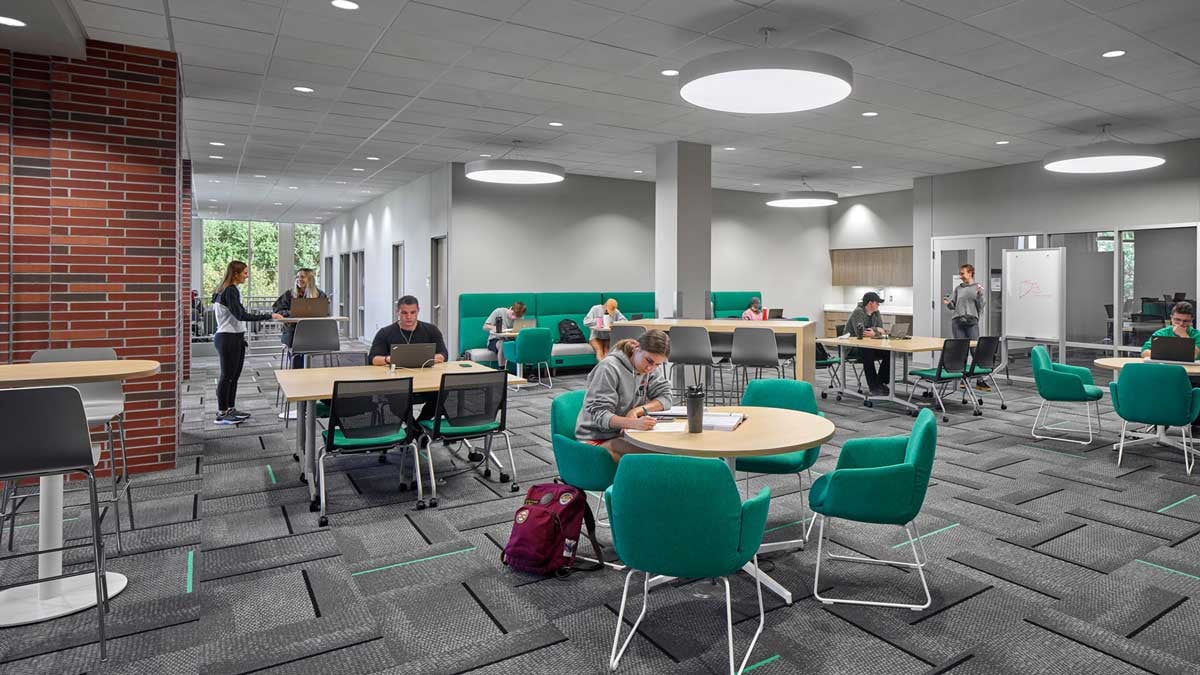Designing for higher education can have a profound impact on the students, faculty, and employees that use and inhabit those facilities. Spaces that are thoughtfully designed and purposefully constructed can facilitate learning, promote well-being, and inspire creativity. Educational spaces that are comfortable, functional, and aesthetically pleasing can foster a sense of community and belonging, providing a supportive environment for students to learn and grow. Additionally, spaces that are designed to accommodate different learning styles and abilities can enhance the overall educational experience.
Unisource Solutions, recognized by Haworth as a leading dealer in the Haworth Learning Community of Practice servicing higher education, is committed to designing spaces that enhance the campus experience.

Benefits of Designing Educational Spaces for the Campus Experience
Designing educational spaces with intentionality and purpose can provide significant benefits to the campus experience.
Firstly, an effectively designed learning environment can lead to improved learning outcomes for students. When classrooms are designed to accommodate various learning styles and create an atmosphere that is conducive to learning, students are more likely to stay engaged, retain information, and perform better academically.
Secondly, an enhanced campus experience can also lead to increased student engagement and satisfaction. By providing spaces that are comfortable, visually appealing, and functional, students are more likely to spend time on campus and take pride in their learning environment.
Finally, an effective design can also contribute to the development of a robust campus culture and community. When spaces are designed to facilitate collaboration, interaction, and communication, students and faculty are more likely to connect with one another, fostering a sense of belonging and community.
How to Create Flexible Spaces that Adapt to Change
Creating flexible spaces that can adapt to changing needs is a critical aspect of designing educational spaces. To achieve this, designers can incorporate multi-functional furniture and fixtures that can serve multiple purposes and can be reconfigured as needed.
Modular design and mobile furnishings also provide flexibility, allowing spaces to be easily adapted to changing needs. The Haworth Openest collection, which features flexible, multi-functional pieces that can be easily reconfigured to suit changing needs, is a good example of modular furnishings.
Additionally, scalable technology solutions are important for creating adaptable spaces. When educational spaces incorporate technology that can be easily upgraded or expanded as needed, it ensures that the learning environment can keep pace with changes in educational technology and instructional methods.

How to Enhance Educational Experiences through Inclusive Design
Inclusive design is an important consideration when designing educational spaces, as it ensures that everyone can access and benefit from the learning environment.
To enhance experiences through inclusive design, designers can incorporate universal design principles that prioritize accessibility and functionality for all users. This can include features such as ramps, wide doorways, and accessible furniture to accommodate people with physical disabilities.

Sensory-friendly spaces are also important, particularly for individuals with sensory processing disorders or other special needs. By incorporating features such as sound-absorbing materials, adjustable lighting, and calming colors, designers can create environments that are comfortable and welcoming for everyone. Haworth Enclose frameless glass partitions can be used to create spaces that are acoustically sound and visually appealing, while minimizing sensory overload.

The Bluescape digital collaboration platform by Haworth can be customized to support universal design principles by incorporating accessibility features such as closed captioning and color contrast settings.
Creating Areas for Collaboration and Relaxation
Creating areas for collaboration and relaxation is an essential aspect of designing educational spaces that promote well-being and engagement.
To create collaborative spaces, designers can incorporate co-working and social spaces that allow students and faculty to work together in a comfortable and supportive environment. These areas can be equipped with ergonomic seating like Very chairs and lounge seating like the Riverbend & Pebble customizable sofa sectional, both from Haworth.

Outdoor learning and gathering areas are also effective for promoting collaboration and relaxation, providing students and faculty with access to fresh air and natural light while fostering a sense of community and connection with the environment.
To promote relaxation, designers can create meditation and mindfulness rooms that provide a quiet and calming space for reflection and relaxation. These areas can be equipped with soft lighting, comfortable seating, and tools such as meditation cushions or sound machines to support relaxation and focus.

From Campus to Classroom
Designing spaces for higher education is critical for creating an environment that promotes learning, well-being, and engagement. By incorporating flexible design, inclusive features, technology, and sustainable practices, educational spaces can meet the changing needs of students, faculty, and staff for years to come.








